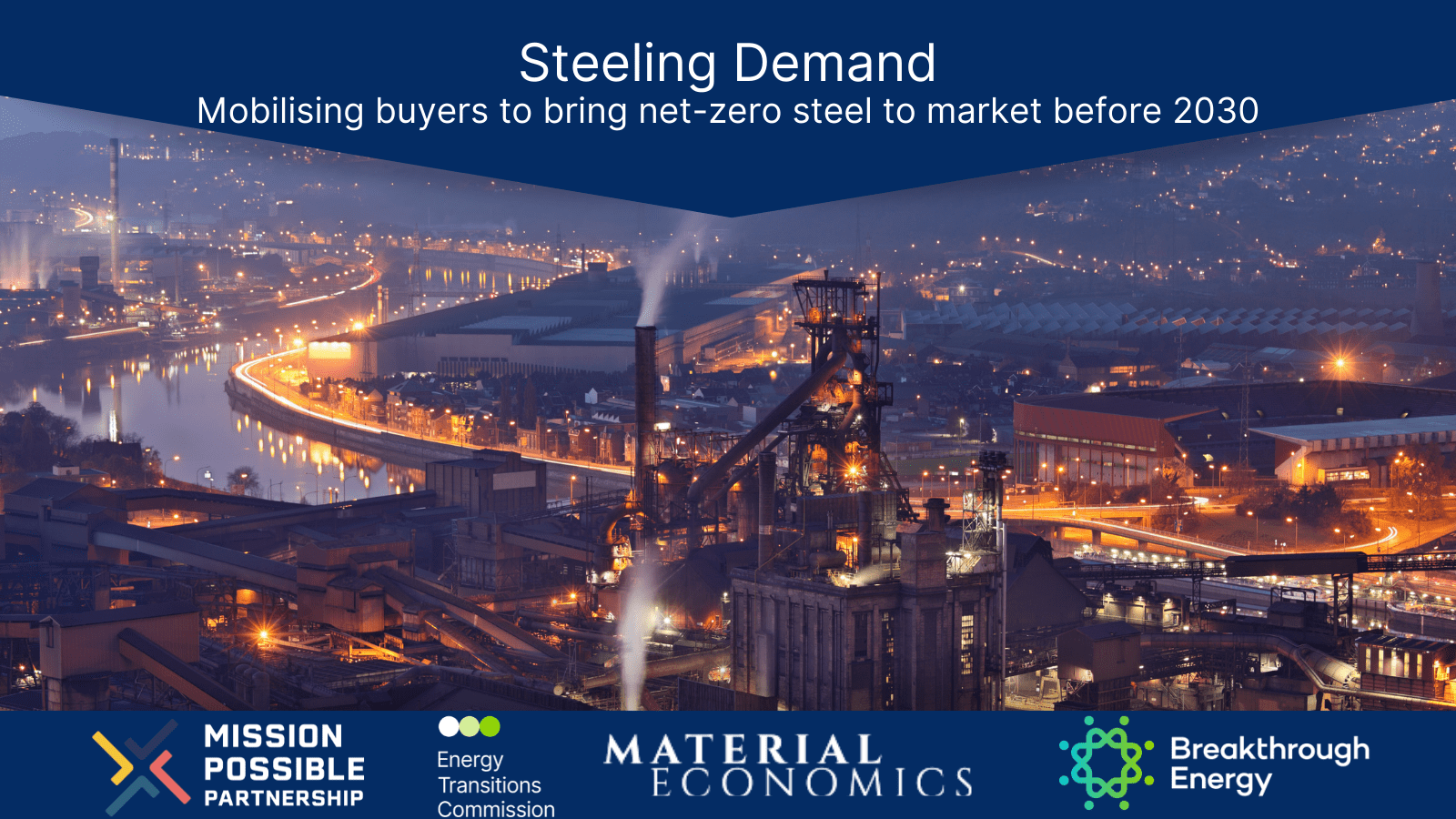Steeling Demand: Mobilising buyers to bring net-zero steel to market before 2030 demonstrates that demand signals from steel buyers to steel manufacturers can unlock investment decisions and bring forward the breakthrough technologies necessary for bringing net-zero primary steel to market.
The report was developed in close collaboration with industry leaders by the Energy Transitions Commission and Material Economics on behalf of the Mission Possible Partnership’s Net-Zero Steel Initiative and with the support of Breakthrough Energy. It provides guidance for critical stakeholders in major steel consuming sectors on how to actively participate in the commercialisation of low-CO2 primary steel production technologies and seize the associated commercial opportunity in being leaders in supply chain decarbonisation.
Decarbonising steel is essential to reach net-zero climate targets by 2030 and beyond. The steel industry globally accounted for 2.6 Gt of direct CO2 emissions in 2019, representing about one-quarter of industrial CO2 emissions and 7% of total energy sector emissions (including process emissions). From wind turbines to electric vehicles, steel will be an integral enabler of the energy transition, although it is also a major part of the embodied carbon in many industrial products.
“Growing demand for low-carbon materials such as steel remains a critical, but underdeveloped, piece of the puzzle to help industry decarbonise. This report shows where early markets for low-CO2 steel are most likely to emerge and calls upon industry leaders in the automotive, energy, construction and white good sectors to seize the commercial opportunity of being the first buyers of low-CO2 steel. Our aim is now to continue working with companies across those sectors to secure demand signals that will de-risk investment in the first low-CO2 primary steel production plants”, commented Faustine Delasalle, Co-Executive Director, Mission Possible Partnership.
As the need to deliver deep emissions reductions becomes an increasing priority for steel producers and steel users, finding solutions to reduce their CO2 emissions in the short term and prepare for deeper cuts in the 2030s and 2040s is vital. Producing steel from iron-ore via low-CO2 (and eventually carbon-free) processes will be essential to reach voluntary and regulatory climate targets by 2030 and beyond. The challenge for the whole industry is to commercialise those technologies in the next decade and rapidly bring their cost down.
Direct offtake agreements and future purchase commitments are critical to provide the confidence needed to unlock the flow of investment in low-CO2 steel production assets. For first movers, it can be a commercial opportunity. Steel buyers will be able to secure access to a scarce high-value commodity, benefit from green marketing through higher price points or growing market shares, and pre-empt regulatory changes thereby avoiding potentially costly disruptions in supply chains later on. However, as the technologies are not yet available and remain higher cost than the high carbon alternative, immediate action is needed.
“Securing access to low-CO2 steel will be key to reach the ambitious climate targets set by large steel users and they need to have come quite far on realizing the targets by 2030. With long product development cycles in many industries, 2030 is not that far away and there will be a limited amount of low-CO2 steel available by then. To position themselves for success, it makes good business sense for these steel users to evaluate moving steel into a more strategic purchasing category today, and to form the partnerships needed with steel producers to secure the first volumes of low-CO2 steel”, said Per Klevnäs, Partner, Material Economics.
The report Steeling Demand makes a number of recommendations to stimulate the early market for low-CO2 steel. Specifically:
Steel Buyers and Users:
- For large, direct steel buyers: Engage in bilateral value-chain cooperation initiatives, using the demand to unlock upstream investments and accelerating the transition to net-zero.
- For steel consumers not engaged in direct bilateral negotiations: Engage in the buyers’club initiatives that will be set up for low-CO2 steel (e.g., SteelZero), and commit to as large volumes as possible.
Steel producers:
- Engage with high volume customers to develop the necessary value-chain collaboration and develop a better understanding of what needs to happen from the demand side to bring investments forward.
- Unlock investment in breakthrough technologies by supporting projects with high emissions reductions potential.
Policy makers and public organisations:
- Continue to provide a supportive R&D environment to foster innovation in the steel sector.
- Use public procurement to create early markets for low-CO2 steel between 2025 and 2030. Use COP26 to announce a “green steel procurement” campaign with commitments from nations across the world.
- Decrease the risk for first-mover bilateral agreements on low-CO2 steel by 1) providing CAPEX support that would correspond to the public innovation value of bringing these technologies to commercialisation. 2) Decreasing the OPEX risk in taking a forward position by introducing Carbon Contracts for Difference.
- Set lifecycle emissions standards for key sectors, such as automotive, construction and white goods. which could be act as an important instrument to fast-track deployment of low-carbon materials.
Civil society:
- Educate consumers about the benefits of low-CO2 steel to encourage them to opt for products containing low-C02 steel. This would send a clear signal to the sector and increase the investment rationale for breakthrough technologies.
“Decarbonizing steel will be central to our ability to reach our net-zero goals, and this is the decade when we must create the markets to drive investment and innovation and make zero carbon steel a reality. Public and private sector leaders alike have important tools available to them to jumpstart the zero-carbon steel market, and we hope they seize this opportunity to help the world build the net-zero industries of the future“, Julia Reinaud, Senior Director, Breakthrough Energy.


